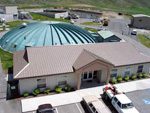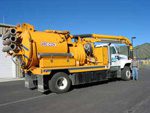The City of Hailey owns and operates a POTW (Publicly Owned Treatment Works) that treats domestic and commercial wastewater. The type of plant is known as an SBR (Sequential Batch Reactor) and the objective of treatment is to remove as much of the nutrients (e.g. nitrogen, phosphorus, dissolved organic matter) and solids (e.g. grit, suspended organic matter) as possible. This is accomplished through several steps and takes about 8 hours from the time the wastewater enters the plant until the discharge is put into the river.

The first concern is to get the wastewater to the plant. This is facilitated by the use of 2 lift stations that each have 2 large pumps to force the wastewater into the plant. These pumps also 'mix' the wastewater so that most waste material is reduced to very small particles. Once in the plant, the wastewater passes through a self-cleaning, cylindrical fine screen that removes all the large pieces of debris like paper towels from the waste stream. Next, the water passes through a grit separator. By going around this whirlpool-like device, the wastewater slows down and lets the heavier material such as coffee grounds and sand fall out and settle in the bottom. The collected grit is then forced up into a grit classifier that washes and dries the grit before depositing it in a dumpster. This completes the preliminary treatment of the wastewater.

#Once all the material that could cause problems in the plant biofouling pumps or plugging pipes is removed, the process moves on to treat the nutrients and organic matter in the wastewater. Other treatment plants also have primary treatment, but this plant goes directly to secondary treatment. During this phase of treatment, the bacteria in the reactor basin remove organic matter by converting it into CO2, water, and more bacteria. They also use up phosphorus and nitrogen in their life cycle. Some of the bacteria require oxygen (aerobic bacteria) to work efficiently and others need an environment without oxygen to their job (anaerobic bacteria). Each type of bacteria excels at a specific job. Some remove ammonia very well while others remove phosphorus better than most.
So, during the secondary treatment, the operator must adjust the environment in the reactor basins to help the different kinds of bacteria do the best they can. The amount of air pumped in, the time with no oxygen, and the time the bacteria are in contact with the wastewater are some ways the operator can change the conditions of the basins.

When the bacteria have done all they can, the next phase of the secondary treatment starts. In this phase, the mixing of the basins is stopped and the bacteria and unused organic matter (sludge) are allowed to settle for a certain amount of time after which the relatively clear supernatant is drawn off the top. At this point the wastewater is done with most of its treatment except for a final filter (tertiary treatment) to remove some of the very fine solids that won't settle and UV (ultraviolet) disinfection to kill any pathogens in the water. Then the water flows, by gravity, to a perforated discharge pipe buried 6 feet under the river.
The last major portion of the process is wasting. When the bacteria reproduce, they produce so many new bacteria that every day a portion must be removed. If they weren't removed, there wouldn't be any settling and the effluent would not meet permit requirements. Ultimately, the wasted bacteria ends up as part of the composting efforts at Ohio Gulch after being hauled by tanker truck and drying in the sun for a few months.
At the Woodside Treatment Plant, this type of treatment works very well. The EPA permit allows us to discharge 30 mg/L of suspended solids (TSS) and 30 mg/L BOD into the Big Wood River. The typical output of this plant is 1 mg/L TSS and 2 mg/L BOD! There are many other tests that must be done on a regular basis to make sure that the treatment plant is not impacting the river detrimentally because the Big Wood has been designated as a Special Resource Water. Many of these tests are run more often than required so that the process can be optimized and any potential problems can be resolved before they impact the river.

